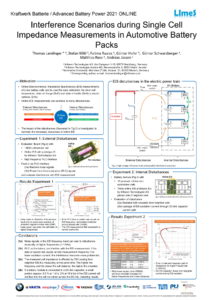Summary:
Electrochemical Impedance Spectroscopy (EIS) of Lithium-ion (Li-ion) battery cells receives growing interest in the field of automotive battery management systems (BMSs), often referred to as “Online EIS“. EIS is a non-destructive measurement method used for battery state estimation such as temperature, state of charge and state of health. To achieve a high measurement accuracy, EIS measurements shall be performed in close proximity to the battery demanding an EIS circuit for each cell. As an HV traction battery consists of hundreds of single cells, many independent EIS circuits are necessary. For this application, Infineon Technologies AG has developed a prototype integrated cell monitoring circuit (CMC), which performs EIS measurements on single-cell level.
From a measurement perspective, the integration of online EIS into the automotive battery pack faces several challenges, which are investigated in this work.
The first experiment deals with external disturbances coming from outside of the battery and is divided into two parts.
(1a) In this experiment, the impact of noise has been investigated. Therefore, a signal generator was used to inject a random white Gaussian noise signal. Typical noise power spectral densities as reported in literature were adjusted to mimic a realistic automotive environment. EIS measurements were performed on an 18650 Li-ion cell mounted on a printed circuit board as shown on slide 4. As visible on slide 5, the deviation between reference and noisy measurement is very small and does only lead to distortions for unrealistic high negative signal-to-noise ratios (SNRs), where the noise power is several decades higher than the EIS excitation power.
(1b) In this experiment, PLC signals were fed during EIS measurement. Distinct disturbances in the Nyquist plot can be observed as depicted on slide 5. This only occurs, if PLC data or packet rates are very close to the EIS measurement frequency. Details on the PLC impact on EIS measurements can be found in our recently published work accessible on https://www.mdpi.com/1996-1073/14/7/1851.
The second experiment aims to quantify internal disturbances. Three EIS CMCs by Infineon are mounted on a battery module as shown on slide 6. Internal disturbances are caused by EMI between neighboring CMCs also known as crosstalk or leakage current through the DC-link capacitor.
(2a) In this experiment, the dependency of the cell-to-cell crosstalk on frequency and distance has been investigated. Therefore, the position of the 3 CMCs was altered among the cells of the module. On slide 7, the cell impedance modulus is shown for a single cell EIS measurement (reference) and a so-called broadcast measurement, where all 3 adjacent CMCs perform EIS measurements simultaneously. As can be seen, there is a significant deviation between reference and broadcast measurement. The table on slide 7 reveals that the highest crosstalk can be observed for adjacent cells, whereas the crosstalk significantly decreases for a distance of 2 cells between CMCs measuring at the same time.
(2b) In this experiment, the dependency of the EIS measurements on the HV DC-link network was investigated. Therefore, EIS measurements with and without connected DC-link capacitor were compared as visible on slide 7, showing a significant difference above 500 Hz. This can be explained by the increasing leakage current caused by the decreasing internal impedance of the DC-link capacitor over frequency.
We are happy to forward your request / feedback.

